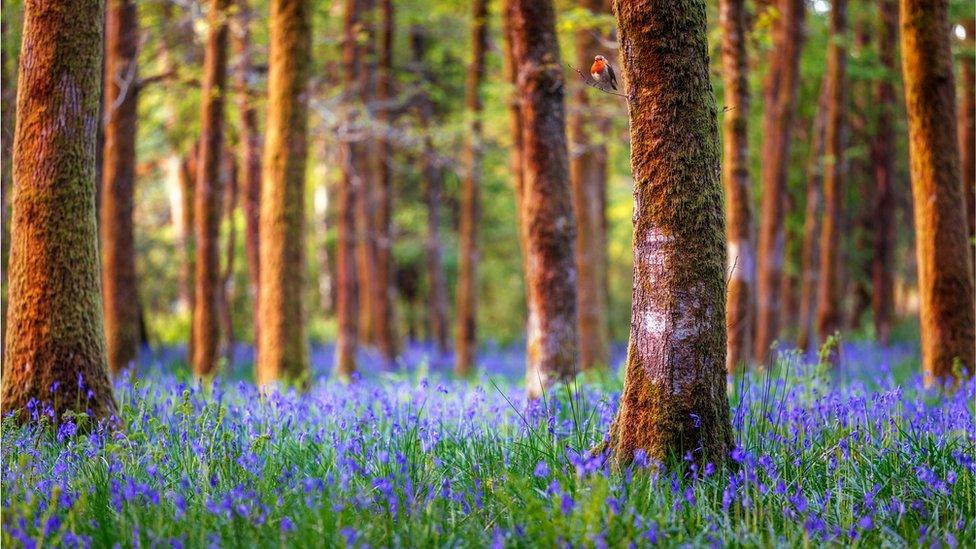Huge project to map DNA of all wildlife in British Isles
- Published
- comments

Scientists want to map the DNA of every single life form, including plants, animals and fungi, in the UK and Ireland - around 70,000 species altogether.
This would be of one of biology's most ambitious projects, and experts say it could transform how we understand the natural world.
It's part of a scheme called the Darwin Tree of Life and it's a very ambitious scientific project.
Read on to find out more.
DNA data
Watch 大象传媒 Science Editor Rebecca Morelle's report
A previous project mapped human DNA and the researchers said it changed human biology forever, how we see ourselves and how we work with our health and illness.
Mark Blaxter, who leads the Tree of Life project, said he wants to make this possible for all of biology, and everyone working on a particular species, to have access to this information.
DNA stands for deoxyribonucleic acid and carries unique chemical information.
It also tells us about genetics - all the instructions that a living organism needs to grow, reproduce and function.
The genome is the entire set of DNA instructions found in a cell. In humans, the genome consists of 23 pairs of chromosomes located in the cell's nucleus.
How many chromosomes each creature has can vary a lot. Humans have 46 chromosomes in each cell. The fruit fly has only 8 chromosomes, while red king crabs have a whopping 208!
The genetic work should show how species relate to each other, and reveal their similarities and also where their differences lie.
The researchers are hoping this project will also have a similar impact to the human biology study, with benefits also when it comes to nature-inspired medicines and materials.
Marine medicines
Kes Scott-Somme, a research assistant on the Darwin Tree of Life project said: "Marine environments are incredibly volatile, and so the animals that live here have to be even more adapted to their space than we are.
"And that means that they have very specific ways of coping with their environment. This could help us to find things like antibiotics, medicines and materials.
"The marine environment is a great place to look for that information."
Testing labs
The samples are sent to the Wellcome Sanger Institute
Different bases all around the UK are taking part in the massive study.
At the Wellcome Sanger Institute in Cambridge, which also played a leading role in the human genome project, samples are arriving every day from all over the British Isles.
They can include anything from a leaf from a tree, to some blood taken from an animal.
The genome of the European badger has now been sequenced as part of the project
The material is weighed, frozen with liquid nitrogen, and and reduced into a fine powder which means the DNA can be extracted, and the genome sequence extracted.
Ming-Shan Tsai from the University of Oxford is taking part in the project. She said: "The genome can answer so many questions that we couldn't answer before," says
The research covers every kind of habitat, from earthworms living in mud at the bottom of the sea, and tiny creatures in rockpools, to animals living in the woods.
Pond life
Rock pools hold many different species which could help to inspire nature-based medicines or materials
But some life forms are so tiny extracting what is needed can be a challenge.
Within a single drop of pond water, are many single-celled organisms known as protists. They are plants, coming under the heading of micro algae.
Life on Earth began with single-celled organism like these, and we could not exist without them - they actually produce about half of the planet's oxygen supply!
Jamie McGowan, from the Earlham Institute in Norwich said: "Having their genome sequenced is really important to be able to identify them. Their biodiversity is so poorly understood. And we need to protect them, because they're so critical for all of the rest of life."
This single-celled organism was found in some pond water
"They're really hard to identify, because some of them look really similar. And they're hard to sequence too because they're starting off with really, really tiny amounts of DNA."
The Darwin Tree of Life project is extremely ambitious with the scientist hoping to have all 70,000 species sequenced and recorded by the end of 2030.
There is a lot of work to do, but if this project succeeds it could give us our most detailed understanding yet of the diversity of life here on earth.
- Published30 April 2020
- Published10 October 2019
